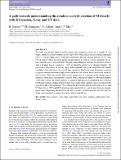Files in this item
A path towards understanding the rotation-activity relation of M dwarfs with K2 mission, X-ray and UV data
Item metadata
| dc.contributor.author | Stelzer, B. | |
| dc.contributor.author | Damasso, M. | |
| dc.contributor.author | Scholz, A. | |
| dc.contributor.author | Matt, S. P. | |
| dc.date.accessioned | 2016-12-05T10:30:25Z | |
| dc.date.available | 2016-12-05T10:30:25Z | |
| dc.date.issued | 2016-12-01 | |
| dc.identifier | 248127290 | |
| dc.identifier | 04fe24d0-bdcf-4ecf-859e-199361a06f7b | |
| dc.identifier | 85006892047 | |
| dc.identifier | 000388122400056 | |
| dc.identifier.citation | Stelzer , B , Damasso , M , Scholz , A & Matt , S P 2016 , ' A path towards understanding the rotation-activity relation of M dwarfs with K2 mission, X-ray and UV data ' , Monthly Notices of the Royal Astronomical Society , vol. 463 , no. 2 , pp. 1844-1864 . https://doi.org/10.1093/mnras/stw1936 | en |
| dc.identifier.issn | 0035-8711 | |
| dc.identifier.other | BibCode: 2016MNRAS.463.1844S | |
| dc.identifier.uri | https://hdl.handle.net/10023/9934 | |
| dc.description.abstract | We study the relation between stellar rotation and magnetic activity fora sample of 134 bright, nearby M dwarfs observed in the Kepler Two-Wheel (K2) mission during campaigns C0-C4. The K2 light curves yield photometrically derived rotation periods for 97 stars (79 of which without previous period measurement), as well as various measures for activity related to cool spots and flares. We find a clear difference between fast and slow rotators with a dividing line at a period of ~10 d at which the activity level changes abruptly. All photometric diagnostics of activity (spot cycle amplitude, flare peak amplitude and residual variability after subtraction of spot and flare variations) display the same dichotomy, pointing to a quick transition between a high-activity mode for fast rotators and a low-activity mode for slow rotators. This unexplained behavior is reminiscent of a dynamo mode-change seen in numerical simulations that separates a dipolar from a multipolar regime. A substantial number of the fast rotators a revisual binaries. A tentative explanation is accelerated disc evolution in binaries leading to higher initial rotation rates on the main sequence and associated longer spin-down and activity lifetimes. We combine the K2 rotation periods with archival X-ray and UV data. X-ray, FUV and NUV detections are found for 26, 41, and 11 stars from our sample, respectively. Separating the fast from the slow rotators, we determine for the first time the X-ray saturation level separately for early- and for mid-M stars. | |
| dc.format.extent | 21 | |
| dc.format.extent | 3003448 | |
| dc.language.iso | eng | |
| dc.relation.ispartof | Monthly Notices of the Royal Astronomical Society | en |
| dc.subject | Stars: activity | en |
| dc.subject | Stars: flare | en |
| dc.subject | Stars: late-type | en |
| dc.subject | Stars: rotation | en |
| dc.subject | Ultraviolet: stars | en |
| dc.subject | X-rays: stars | en |
| dc.subject | QB Astronomy | en |
| dc.subject | QC Physics | en |
| dc.subject | DAS | en |
| dc.subject.lcc | QB | en |
| dc.subject.lcc | QC | en |
| dc.title | A path towards understanding the rotation-activity relation of M dwarfs with K2 mission, X-ray and UV data | en |
| dc.type | Journal article | en |
| dc.contributor.institution | University of St Andrews. School of Physics and Astronomy | en |
| dc.contributor.institution | University of St Andrews. St Andrews Centre for Exoplanet Science | en |
| dc.identifier.doi | 10.1093/mnras/stw1936 | |
| dc.description.status | Peer reviewed | en |
| dc.identifier.url | http://adsabs.harvard.edu/abs/2016MNRAS.463.1844S | en |
This item appears in the following Collection(s)
Items in the St Andrews Research Repository are protected by copyright, with all rights reserved, unless otherwise indicated.

